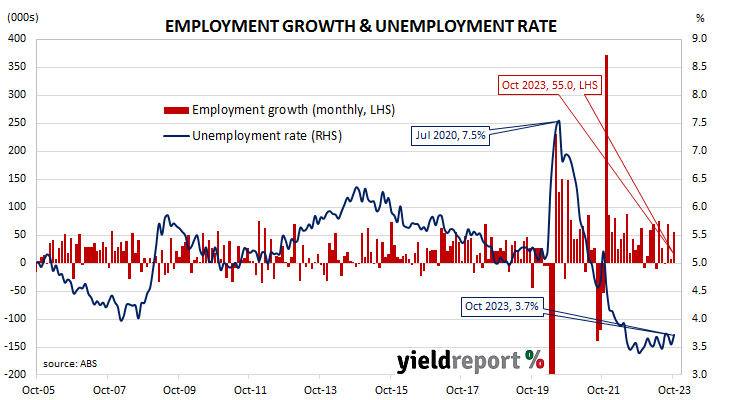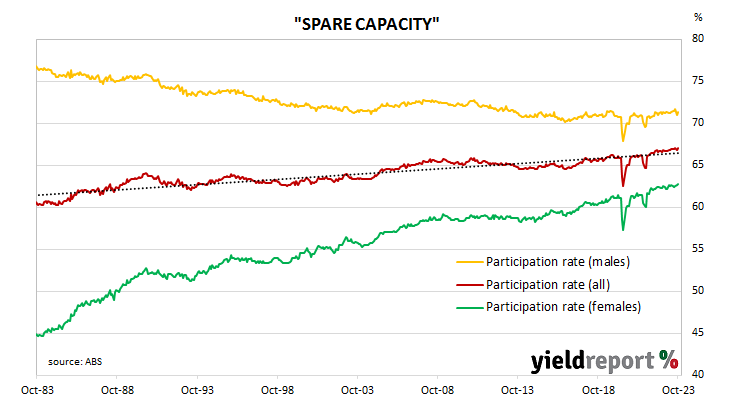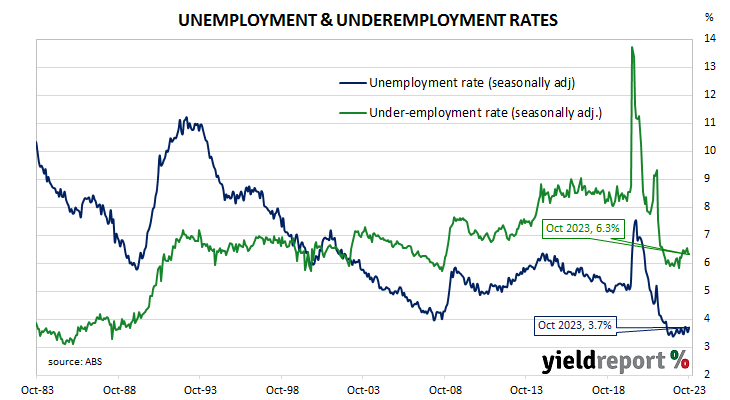Summary: Employment up 55,000 in October, more than expected; Westpac: solid report conceals softening trend; Citi: some noise from temporary employment associated with referendum; participation rate rises to 67.0%; jobless rate ticks up to 3.7%; more part-time, full-time jobs; aggregate work hours up 0.5%; underemployment rate down from 6.4% to 6.3%.
Australia’s period of falling unemployment came to an end in early 2019 when the jobless rate hit a low of 4.9%. It then averaged around 5.2% through to March 2020, bouncing around in a range from 5.1% to 5.3%. Leading indicators such as ANZ-Indeed’s Job Ads survey and NAB’s capacity utilisation estimate suggested the unemployment rate would rise in the June 2020 quarter and it did so, sharply. The jobless rate peaked in July 2020 but fell below 7% a month later and then trended lower through 2021 and 2022.
The latest Labour force figures have now been released and they indicate the number of people employed in Australia according to ABS definitions increased by 55,000 in October. The result was greater than the 24,500 increase which had been generally expected as well as September’s 7,800 gain after revisions.
“Overall, the October Labour Force Survey was a solid report in regard to employment growth and hours worked, concealing what has been a trend softening in labour market conditions over recent months,” said Westpac economist Ryan Wells.
Domestic Treasury bond yields either rose modestly or remained steady on the day, largely ignoring noticeably higher US Treasury yields overnight. By the close of business, the 3-year ACGB yield had returned to its starting point at 4.18%, the 10-year yield had added 2bps to 4.56% while the 20-year yield finished unchanged at 4.87%.
In the cash futures market, expectations regarding further rate rises softened a touch. At the end of the day, contracts implied the cash rate would remain close to the current rate of 4.32% and average 4.325% through December and 4.39% in February. May 2024 contracts implied a 4.435% average cash rate while August 2024 contracts implied 4.395%, 8bps more than the current rate.
“There was some noise from temporary employment associated with the October 14 referendum for the RBA to wait for a ‘cleaner’ set of numbers that would also reflect the latest increase in the cash rate target,” said Citi economist Josh Williamson.
The participation rate rose from September’s revised figure of 66.8% to 67.0% as the total available workforce increased by 82,900 to 14.721 million while the number of unemployed persons rose by 27,900 to 547,800. As a result, the unemployment rate ticked up from 3.6% to 3.7%.
The aggregate number of hours worked across the Australian economy increased by 0.5% as 37,900 residents gained part-time positions and 17,100 residents gained full-time positions. On a 12-month basis and after revisions, aggregate hours worked increased by 1.7% as 203,600 more people held part-time positions and 215,300 more people held full-time positions than in October 2022.
More attention has been paid to the underemployment rate in recent years, which is the number of people in work but who wish to work more hours than they do currently. October’s underemployment rate remained unchanged from September’s revised figure of 6.3%, 0.5 percentage points above this cycle’s low.
The underutilisation rate, that is the sum of the underemployment rate and the unemployment rate, has a strong correlation with the annual growth rate of the ABS private sector wage index when advanced by two quarters. October’s underutilisation rate of 10.0% corresponds with an annual growth rate of about 4.2%.




